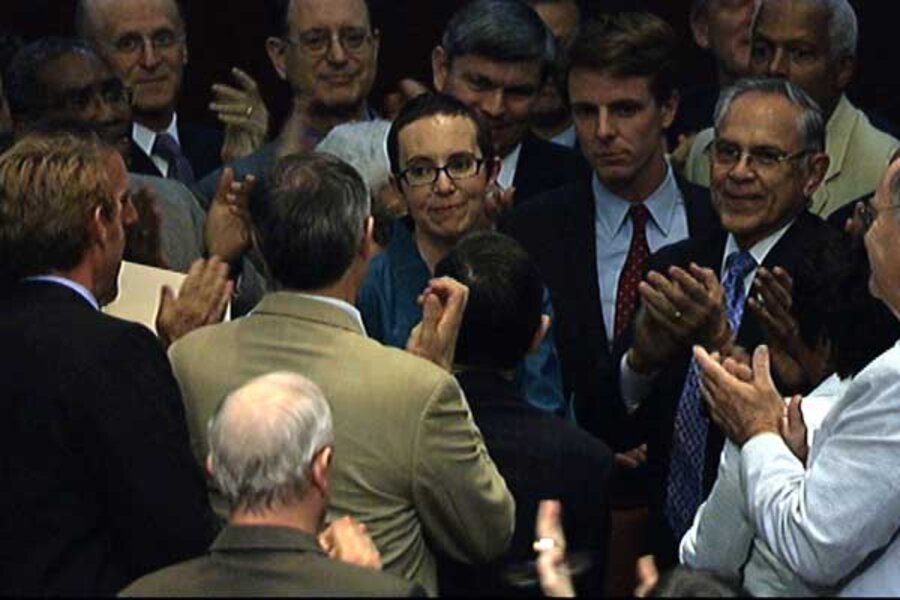Debt-ceiling bill clears House. Now, hopes that Round 2 will be better.
Loading...
| Washington
In a vote laced with surprises, the House passed a controversial plan to add more than $2 trillion to the nation’s debt limit, just a day before the nation was to lose its capacity to borrow.
The bill now heads to the Senate, where it is expected to pass in a vote beginning at noon on Tuesday. President Obama says he will sign it by sundown, avoiding the first-ever default on the full faith and credit of the United States.
But the cheers that rang through the House chamber during the vote were not for the debt deal, which was highly unpopular on both sides of the aisle, but for the surprise appearance of Rep. Gabrielle Giffords (D) of Arizona, whose recovery from an assassination attempt on Jan. 8 inspired her House colleagues and the nation.
“I strongly believe that crossing the aisle for the good of the American people is more important than party politics,” she said in a statement. “I had to be here for this vote. I could not take the chance that my absence could crash our economy.”
In the end, 95 Democrats, including Congresswoman Giffords, joined 174 Republicans to pass the compromise bill, whose fate appeared to be in doubt right up until the final vote. The Congressional Progressive Caucus and the Congressional Black Caucus both opposed the measure, citing harm to working families and the poor from some of the expected spending cuts.
But both sides won their way to the compromise with a modest claim: It's a start.
'A solid first step'
Republicans held out hope that entitlement reform would be next on the agenda, both for a new congressional committee tasked with identifying $1.2 trillion more in cuts and beyond. Meanwhile, Democrats hoped that taxes on the wealthy could be part of a second wave of deficit cutting.
“I would like to say this bill solves our problem. It doesn’t. It’s a solid first step,” said Rep. Jeb Hensarling (R) of Texas, the House Republican Conference chairman, during Monday’s floor debate.
“Although not perfect, [it] will begin to change the culture here in Washington,” said House majority leader Eric Cantor (R) of Virginia at a press briefing before the final vote.
“Beginning to take steps toward fixing our fiscal problems will in fact provide more confidence for employers in America,” said Speaker John Boehner (R) of Ohio at the briefing.
Many bills that eventually take on big issues start as a modest, first step, says Julian Zelizer, a congressional historian at Princeton University, citing the 1957 civil rights bill, which disappointed most of its supporters for not going far enough to redress the nation’s record on civil rights.
President "Lyndon Johnson pushed back against liberals saying, 'If I can get Southerners to vote for something, you can do more down the road,' ” he says.
“The debt deal is trying to give some assurance that it’s a first step and will continue,” he adds. “The legislation is vague enough about this new committee that everyone can look at it and think that the committee will later give them what they want.”
Indeed, with 66 of 240 Republicans voting to oppose raising the debt ceiling, Democrats – including Giffords – were critical to passing the bill.
The compromise bill hikes the debt limit in two stages, while requiring comparable spending cuts each time. The first debt-limit hike and corresponding spending cuts – totaling about $900 billion – will take effect immediately. Then, a new bipartisan committee composed of members from the House and the Senate is to recommend at least another $1.2 trillion in spending cuts by Thanksgiving, which are expected to move through the Congress on an expedited procedure by the end of December.
How GOP freshman voted
Throughout the months-long process, the 87-member Republican freshman class were seen as the roadblock to raising the debt ceiling. While they rejected the final plan at a higher rate than did other Republicans, 56 supported the bill in the end.
Freshman Rep. Tim Griffin (R) of Arkansas, a member of the House Armed Services Committee, was one who voted "no." He says he’s worried about the fact that the Pentagon budget will be cut automatically if the new congressional committee fails to identify and pass its additional cuts.
Freshman Rep. Steven Palazzo (R) of Mississippi says that the deal doesn’t go far enough to get the nation back on a sustainable course but is a step in the right direction. He voted with GOP leadership to back the bill.
“We’re headed toward the brink of disaster whether we raise the debt limit or not,” he says.
Like many other GOP freshman, Congressman Palazzo says he was not pressured by Speaker Boehner or other GOP leaders to vote for the plan. “He gives us the facts and lets us make up our own minds,” he adds.
For Rep. Paul Ryan (R) of Wisconsin, the chairman of the Budget Committee, the logic was clear.
In a floor speech before the vote, Congressman Ryan said that Republicans had won two-thirds of the spending cuts they had wanted: “That’s better than zero.”





